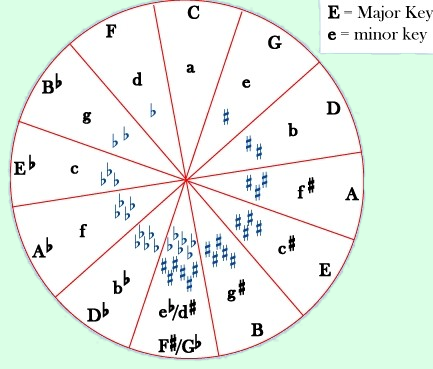Key Signatures
A song may have a note area in which you can comfortably sing or play. In fact, you may easily perform all the tones, both high and low, in a particular Key. We see Key Signatures appear before time signatures in sheet music.
Sharp (#) and Flat (b) symbols are populated on the staff in a certain order (that we'll learn soon). The number of symbols together represent a Key - a tonal area, or range, of a song.
Many Keys emerge by adding an additional sharp or flat, on the staff's lines and spaces. Only sharps, or only flats will appear, never mixed. The total number of sharp or flat symbols is seven. And none, some, or all seven symbols may fill a staff.
Sharps
No sharps or flats on the staff makes the Key named C, so it's easy to memorize. Next, to change Keys, we need an Order, on which line or space, to add Sharps. Just memorize this letter sequence :
F C G D A E B
Use this acronym for memorization :
Fat Cats Go Down Alleys Eating Birds

F C G D A E B
Those are all seven sharps. How do sharps relate to Keys? When we add a sharp on the staff, that same note will be played a half step higher every time it appears in a song. Whatever sharp shows up on the staff, that note gets sharped every time it's played, throughout a song. This is to save writing or printing the symbol on that note every time it appears, like a shorthand at the start of a song.

F#
To find the name of the Key, we'll focus on Major Keys : With the last sharp you place on the staff (in Order FCGDAEB) - raise it a half step to get the Name of the Key. Place one sharp on the staff, F#. Raise it a half step, to G, and G Major is our Key's name. So a song will follow the G scale notes, with F sharped every time it appears :

F# C#
Next, add two sharps, F#, C#. Since the last sharp added was C#, raise it a half step to get the Name of the Key, D Major. The D Major Scale has two sharps, F#, C#. To create melodies in this key, just rearrange the D scale notes into phrases that sound good to you. Also, to create chords, use triads within the D Major Key :
"... when numerous sharps or flats appear on the staff, find which notes are natural, as they're fewer to remember."
Have you noticed that the last sharp is the Major Scale's seventh note? Notice how sharps manipulate certain notes, to produce the Major Scale Sound (based on whatever root note).
The sharped seventh is the 'leading tone'. This is because it leads to the root, by being the 2nd to last note in the scale. Also, the 7th Sounds like it wants to resolve to the Root note, to get back 'home'. Ain't it always about the sound? :)
Flats
The Order of Flats placed on the staff is the opposite of sharps' order :
B E A D G C F
Memorize this Order of Flats with :
BEAD -GCF (spelling bead, then gcf)

B E A D G C F

Bb
No flats on the staff is, again, the Key of C Major. One flat (Bb) on the staff is F Major. Easily memorize the Keys of C and F :
By our logic, the 7th note in the F Major Scale is E natural, and cannot be the second to last flat (shown in the next section). Therefore, we can't use the order of flats, and must remember the key signature for F Major.
The same goes for the C Major Scale, whether we consider it a flat or sharp scale, it won't work using the order technique. Both scales are due to B,C, and E,F exceptions.

Bb Eb
And now, to find the Key Name from Flats :
Use the second to last flat that you added. That flat is the name of the Key. If we add two flats, Bb, Eb, the second to last flat is Bb. This becomes the Key Name, Bb. In this Key, every B and E that appears in the song will be lowered a half step (notice the double Bb) :

Bb Eb Ab
Add one more flat on the staff, Bb, Eb, Ab. Here, the second to last flat is Eb. The Key Name is now Eb, with every BEA notes flatted, or lowered a half step. The name of the key is the Root note, toward which the other notes in the key resolve :
Another Way to Add Flats
Notice that every added flat lands on the 4th scale note, and the Root (1st note) is flat (except for the key of F). So for scale memorization, the two flat notes are 1st and 4th. Then, backing up from the 4th note, we use the order of flats to find the remaining flat scale notes :
- Ab Bb C Db Eb F G Ab
- 1 4 8
- Ab = Root 1,8
- Db = 4th note
- reverse flat order (BEADGCF) = Db Ab Eb Bb
- 4th, root, Eb Bb (DAEB=BEAD)
Therefore, the Ab Major Scale has 4 flats (with GCF notes natural). We counted backwards from the Db in the order of flats, to get Db Ab Eb Bb. The 4th note of the scale is Db, and you can start on the 4th note of any Flat Scale to find the number of flats.
If this way seems confusing, use the second to last flat method.
These key ranges are basically a root note whose scale has to sound a certain way. Here, we add sharps or flats to make the notes sound Major. From lower root note to upper root note is a good place to find a comfortable key.
Let's see the Db scale: Db Eb F Gb Ab Bb C Db
Start from the 4th note, Gb. Then, in the Order of Flats, count backwards from there: G D A E B. Notice that the notes C and F are natural. So in this particular scale, we can simply remember to flat everything, except C and F.
Circle of Fifths

The Circle of Fifths shows which sharps or flats are in a key. The sharps and flats increase as we get closer to the bottom of the chart. They're placed on the staff in the same order they appear here. Also, the lowercase letters above are the minor key's root notes (a e b ...)
Going around the circle from top, clockwise (right side), each root note is five half steps below the previous one (C,G,D ...). From top, counterclockwise (left side), each root note is five half steps above the previous one (C,F,Bb ...). This isn't as important as knowing the number of flats or sharps for that root.
Musicians are familiar with quickly figuring the Key from its Signature, especially seeing the last sharp, or second to last flat. Regardless of Major or minor Keys, the Sharps and Flat's Order remains the same.
Each piece of the circle has a Major and minor letter that has the same number of sharps or flats. It's interesting that starting on another scale letter can have a different sound, Major or minor.
Finally, a Key Signature can change in the middle of Sheet Music. This probably means the background chords have a new tonal center, which creates a new feel. Also, when numerous sharps or flats appear on the staff, find which notes are natural, as they're fewer to remember. Then, raise or lower a half step, every note except the naturals.
The root notes at the bottom of the Circle of Fifths overlap because the Major sharp and flat note is the same, but each have a different name. Also, there's a different name for the same minor root notes. Both Major and minor keys have one note for sharps, and one for flats.
A practice technique is to play a written song in a key more comfortable for us, or to transpose it. We may keep our easier key in mind, while reading the written key. The intervals between the written notes are cues to sharp, flat, or naturalize our transposed song (from the original key). Transposing takes skill.
Recommended reading: Sharp Flat Rule; Enharmonics
The next page is about Clefs, a helpful way to visualize the highest and lowest sounds.
